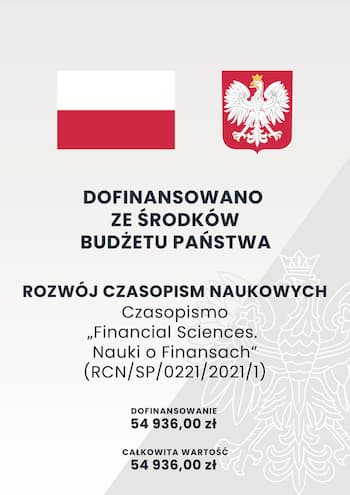Issues
Click a year to expand it.
40 Points
on Ministry of Education and Science journal evaluation list of 2024

Search results for query: Wiśniewski
Sort by: Relevance Author: Ascending Descending Year: Ascending Descending
- The social impact bond as a financial instrument
Author: Marcin Wiśniewski
See Issue Contents: fins.2018.4
Abstract:Social impact bonds are an innovative mechanism for financing social tasks with the financial resources of private investors. The repayment of the capital invested and capital gains depends on obtaining a predetermined social aim that is paid for by the public side under the “payment for results” formula. The previous work on this mechanism focused mainly on its task and organizational dimension. In this paper, the author attempts to define the social impact bond as a financial instrument. In particular, the financial side of the mechanism is considered. First, an attempt is made to determine the place of the social impact bond in the theoretical classifications of financial instruments. Second, the place of the instrument is indicated in the system of financial law. Finally, some remarks are made on the need to have the new instrument regulated in Polish legislation
- Comparison of investment performance measures using the example of selected stock exchanges
Author: Marcin Potrykus
See Issue Contents: fins.2018.2
Abstract:In this paper the main objective is to examine whether the selection of the performance measure influences the evaluation of individual investments and the performance rankings generated on that basis. This study presents the values of 16 performance indicators along with their detailed descriptions. All calculations were made using the R program, and the source code can be found at the end of the article. Nine selected stock indices were analysed during the period January 1997– December 2015, and the monthly logarithmic rates of return for these indices were calculated. For 14 out of the 16 measures analysed it was shown that the choice of effectiveness measure had no influence on the evaluation of individual investments; therefore it is not important whether the investor uses the Sharpe ratio or the Calmar ratio as an indicator of efficiency since both measures are almost identical in rank for a particular investment. This has not been confirmed for the Upside Potential ratio, which means that using this indicator may lead to different investment decisions in which the objective is to maximize efficiency. Moreover, based on the analysis it was found that the OMXC 20, DAX 30, and OMXS 30 indexes had the highest efficiency during the period January 1997–December 2015, while the AEX, WIG 20, and PSI 20 indexes were characterized with having the lowest levels of efficiency
Newsletter






